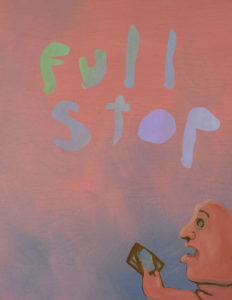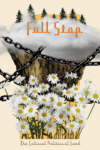The following is the introduction to the latest issue of the Full Stop Quarterly. You can purchase the issue here or subscribe.
•

Jenifer Evans
When you open the IUCN Red List website, one of the first things you’ll notice is a teardrop shaped slideshow on the right that slowly moves between images of animals, insects, plants, and other species who have found themselves placed on the “Red List,” a moveable feast of biodiversity under attack. As the slideshow continues, a second teardrop moves along a slider that denominates these species as “Near Threatened,” “Vulnerable,” “Endangered,” “Critically Endangered,” “Extinct in the Wild,” or “Extinct.” There is another label on the far left, but it is never—or perhaps only rarely—highlighted: “Least Concern.” The implication being, of course, that we should always be concerned.
The teardrop is red, until it’s not. Until the species is “Extinct.” Then, though the photograph of the animal or plant or insect is no different than any other, the teardrop is black. This is where I, at least, look away. It is strangely affecting, this wordless change of colors, unaccompanied by any obvious call to action. For those, you have to navigate the site itself, at which point you will find that these calls to action are for collective, systemic change.
It is too easy, anymore, to see the worst in situations. To find fear overwhelming. To project a seemingly inexhaustible capacity for evil onto the world, or at least other humans. In the face of that, it seems absurd, naïve, even morally inexcusable, to call for optimism and earnestness. Realism has failed us, and utopianism hasn’t done much better on our behalf. Yet realism is not all there is, and as any writer who has sent in a completed draft will tell you, a perfect work is not the only thing worth fighting for. What else is writing but a way by which we attempt to make another world?
In July of this year, New York Magazine published an article titled “The Uninhabitable Earth,” about the various worst-case scenarios that await our planet in some near or far future. When that article was published, there was panicked outcry from many in the environmentalist community—all that the piece was going to do was make people afraid, many argued, and fear would never spark action. But we should be afraid: the threat is very real. Unfortunately, we don’t know what to be afraid of, because the stories we tell ourselves are incapable of narrating beyond a human subject.
This was the crux of Amitav Ghosh’s 2016 book The Great Derangement, in which he argued that “the climate crisis is also a crisis of culture, and thus of the imagination”: literary fiction has failed to address climate change in anything other than a rare and oblique fashion because the pervading style of literary fiction rests on a refusal of the extreme. The tyranny of the everyday finds itself stymied by a world in which climate extremes, environmental displacement, and mass extinction have themselves become everyday occurrences for large segments of the human population.
So much for “literary fiction,” perhaps. This, after all, has been one of Full Stop’s goals from day one: to search out other forms of writing, other ways of telling, other stories worth reading. From gothic morality tales to magical realism, from the road to Damascus to the cliffs of Northern California, from misguided hope for corporate salvation to the grotesquerie of empathy, there are writers and artists whose work challenges passivity. This work demands attention, demands consideration, demands engagement in all its difficulty.
The pieces you will find in this issue of the Full Stop Quarterly address not just the end, but perhaps what happens after: what happens after borders have been erased or at least muddled beyond recognition, after lives have been threatened or wiped out, after The Big One hits and our cities sink beneath the waves. If speculative fiction can teach us anything, it’s that the end of the world is only the end of a world, after all. Perhaps humans will find another home in space, or perhaps we will finally turn our eyes back to the earth, back to our stories, and realize that we are firmly embedded in this soil. But we don’t have to wait, these writers will tell us. We can do this now.
This post may contain affiliate links.







